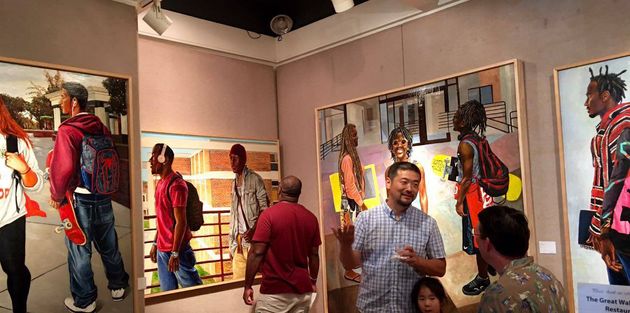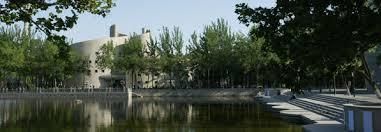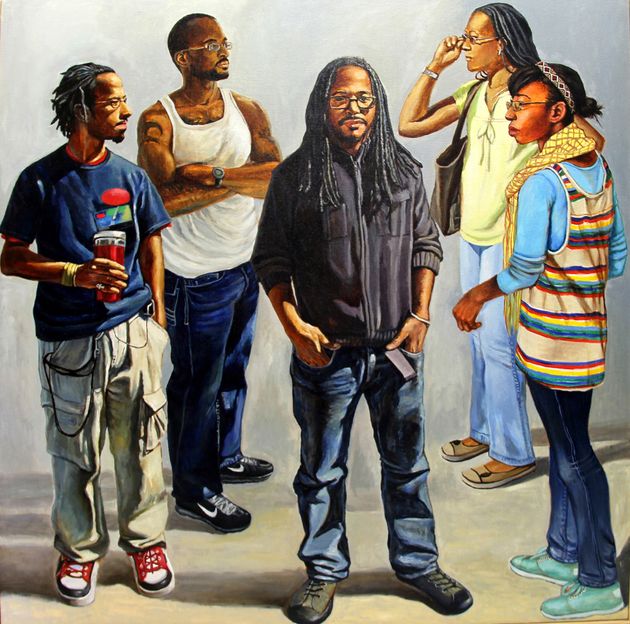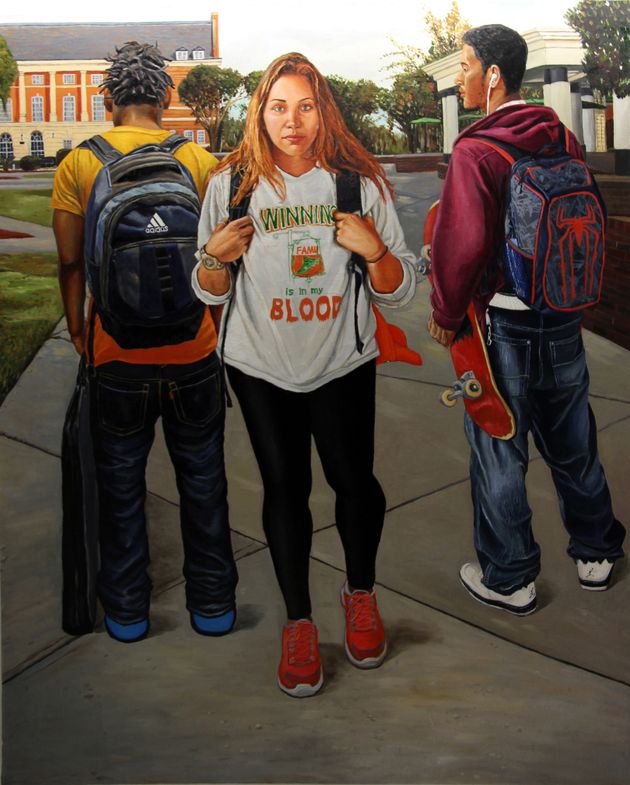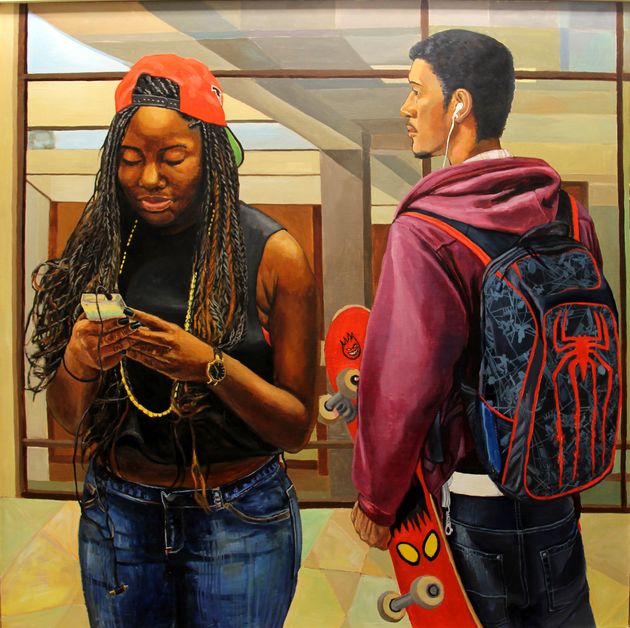Nan Liu, Communication, Oil on canvas, 83 x 60 inches, 2013
Nan Liu, a classically trained artist who received his rigorous education in China, is delighted by the landscape and people of Florida. In contrast to the place where he grew up and was educated—in a heavily populated and smoggy region of Northern China—Nan Liu sees the “Sunshine State” as a place of creative energy and natural beauty.
His current exhibition at The LeMoyne Center for the Visual Arts, Nan Liu’s Cross-Cultural Perspective, displays the artist’s works in a wide variety of media—including drawings, watercolors, oils and brush-painted Chinese scrolls—and also features his recent group portraits of Florida A&M students. Interested in capturing the energy and vitality of his subjects, who are predominantly African-American, Nan Liu’s goal is to portray their essential activities and poses. He has already completed ten of these paintings and hopes to have completed ten more by the end of 2018.
I recently interviewed Nan Liu, and leaned a great deal about his life, his education, and his cross-cultural experiences.
John Seed Interviews Nan Liu
Tell me about your early life and art experiences
When I was 6 years old, I saw several Chinese brush paintings by the famous painter Qi Baishi on the wall of my grandmother’s house. Qi Baishi had been a neighbor of my grandmother’s father in Beijing and in the 1940s and he had given several Chinese ink paintings as gifts to my great grandfather. So, I began copying those paintings over and over, and in that sense Qi Baishi became my first teacher. Then, when I was nine years old, my mother began sending me to a local children’s palace to study Chinese brush painting on weekends.
In middle school I met my first important teacher and mentor, Mr. Zheng Wen Zhong. His painting studio was next to the classroom and it was filled with many realistic oil paintings and drawings, hung on the walls salon style. Several friends and I took lessons from him after school, learning drawing and tempera painting and copying traditional plaster casts of Greco-Roman sculptures. So, this introduced me to Western academic methods, and it became the golden period of my art education. I never worried about grades, and my friends and I competed in a good way: we always wanted to be the best. Mr. Zheng would come and critique our paintings and drawings. He also encouraged us to consider studying art in college.
When I was 16 years old, one of my drawings won the first place in an international art exhibition. As a result I was honored with the prestigious title, “Young Artist of Tianjin” by the Cultural Committee of Tianjin City. Then, in 1992, I applied to the Oriental Art Department of Nan Kai University where I hoped to study Chinese brush painting. The program had been established by the master artist Fan Zeng who donated his own money to build the art department. Fan Zeng, who had just returned from three years in Paris, is famous for his historical figurative ink paintings and as an advocate of new literati painting. In Japan, there is a museum dedicated to him.
It was the first art department in a comprehensive university in China and emphasis on traditional Chinese brush painting. Over 400 students applied that year and only 10 students were ultimately admitted. I was one of the 10, and one of only two from Tianjin City.
How did the admissions process work?
There was a three-day long, on-site art exam taken in April. On the first day, applicants did 20-minute sketches of live, clothed models. At the end of that day a committee reviewed each applicant’s portfolio: about half the students were eliminated in this first round.
The next morning there was a two-hour portrait drawing exam—done in pencil or charcoal—from a live model, followed by an afternoon ink drawing exam done from a live model using a Chinese brush on xuan paper. The next morning there was a Chinese brush painting exam. You could choose your own subject matter, which might be—for example—a landscape, a figure, flowers or birds.
Then there was a calligraphy exam: you were given four sentences of a Tang poem to illustrate in an hour, plus you had another hour to create a calligraphy in your preferred style. On the final morning there was a two-hour painting exam on a given theme, then an oral interview on art history and theory.
Because this entrance exam was so competitive, only 40 students received permission for the final round exam on other subjects: Chinese literature, English, History, etc. After the other subject exams in June, the top ten students were admitted: I was the top one for other subjects that year and was admitted into the program. I was the youngest in my class. Most of my classmates were older than me because they had been taking the admissions exams for many years.
Tell me about the curriculum and courses
I participated in a four year curriculum that was divided by subjects and credits (120 credit hours). The studio classes were held each morning from 8AM to Noon and were divided by subject into multi-week sessions.
For example, during my freshman year, we had a four week long drawing class—plaster casts and portrait drawing—then six weeks of ink painting with a live model, three weeks of BaiMiao line drawing , four weeks of landscape painting, three weeks of flowers and bird paintings, two weeks of calligraphy, two weeks of GongBi painting, etc.
The painting program emphasized traditional Chinese brush painting techniques and concepts. Each course was taught by a different professor. During my freshman and sophomore years, the painting courses focused on foundational skills. The teaching methods were focused on the imitation of our teacher’s works or copying masterpieces from the past: there was a strong emphasis on copying.
In GongBi painting class, we copied paintings created by Professor Yang Shutao, which were in turn copies of Tang Dynasty masterpieces she had made in a museum. We learned how to hold brush to achieve certain line qualities, how to mix certain pigments to achieve certain tones, and how to dye color through layers to achieve the transparency of the color effect.
Among my many teachers, I was most influenced by professor Fan Zeng, especially by his use of simple and vigorous brush strokes and dynamic delineation of form. Professor Fan Zeng painted life-sized figurative paintings right in front of us. He started with eyes, then noses, then the face, then the hands, and so on...
During my Junior and Senior years, art concepts and ideas were emphasized. Students were expected to create artworks based on their own ideas and concepts, applying the techniques they learned from previous years. In 1994, we had a field trip on the Silk Road from Tianjin to Beijing to Xi’an, then Dun Huang during 6 weeks period of time. We visited most famous museums and grottos on the Silk Road. In Senior year we each created a series of paintings, using an assigned studio space, and working with a professor who served as thesis advisor.
What did you do after completing the program?
After four years of undergraduate study, I asked myself: “What was the teaching method adopted by most of my professors?” The answer was, that most often it was the copying or imitation of old masters or professors’ work. I began to wonder if there were different or better strategies or methods for cultivating art students.
I continued to study art education at Capital Normal University (CNU) in Beijing in 1997. During my study in Beijing, in 1998, I assisted with translation work for an international art education symposium held at CNU. I met an American delegation of five art educators. They presented Discipline-based Art Education (DBAE) to Chinese art teachers.
I was interested in learning the DBAE theory in teaching and learning through art. I decided to apply graduate school in the United States to continue my graduate study in art and art education. I wanted to know: what are the teaching methods adopted by American professors teaching art in higher education? How artists were trained in the United States? In 1999 I was admitted by University of Arkansas at Little Rock and given a graduate assistantship.
What was it like to come to the United States? How did you adapt to American culture?
I arrived in Little Rock on August 14, 1999. The next morning was a Sunday morning, a sunny day. My roommate and I took a walk on campus and there were no people on campus: we saw only squirrels around us under the tall pine trees. In Tianjin I was always surrounded by people and could not see squirrels.
In my apartment, there was no furniture. With my roommate Yang Yulong, an engineering student from Shanghai, I ate my first breakfast: ramen noodles eaten on an upside-down laundry box. When my advisor, Dr. Bonnie Black, asked me what did I needed I told her, “I have no furniture in my apartment.” The next day she and her husband drove a Ford truck full of all kinds of furniture to my apartment: a single mattress with boxes and frames. A dining table with four chairs. My first American professor was like a mother to me.
Another cultural shock was that there were cars everywhere on campus. As a college student I was on the bike for many years in China. After I arrived in Little Rock, I saw most students drive their own cars on campus. I made up my mind to buy my own car. Two semesters later, I bought my first car, a second hand 1989 two-door Nissan Sentra for $1200. I felt a sense of freedom after I learned how to drive.
What was it like to receive an American education?
Most of my graduate courses were seminars. So, the professors encouraged students to speak openly and express own opinions. It was difficult for me to do that at the beginning. In China I had been accustomed to listening to the lecture delivered by the professor rather than asking questions or presenting personal opinions. Gradually, I started to raise more questions or express my own ideas in class.
During the first two years, I was also struggling with my English. For the first semester, I could only understand 40 percent of the lecture in art history and my other classes. I used a Walkman to record the lectures, and then borrowed notes from my classmates so I could continue studying into the evening. During my first two semesters I never went to sleep before 1AM.
American professors encourage their students to cultivate more individual ideas and to insert their own thoughts and concepts into works of art. In China, my art classes had emphasized techniques at beginning followed by the development of concepts later on. In one American painting class, my professor did not teach students how to paint but rather what to paint. After each student developed his or her concept, then the professor helped with techniques.
When did you become serious about painting with oil paint and how quickly did you progress?
In China I had only taken seven weeks of oil painting classes as electives. After I came to the U.S. I started to do more oil painting. At the University of Arkansas at Little Rock I worked as a graduate assistant in the painting studio, assisting students. As a result, I was able access to the painting studio 24 hours a day, and I had my own studio space. There were lots of tools for making canvases and I began to stretch my own canvases and paint more oil paintings.
I had my first solo show after the second semester of my MA program. Most of the faculty members and students loved my oil paintings of the TaiHang series and I gained more confidence in my oil painting.
During my second year, there was an annual student art competition. I entered four pieces oil paintings of my TaiHang series and all of them received awards. One piece was purchased by Dean’s office, another by art department and the rest by a private collector. After I finished my M.A at UALR. In 2002, I was admitted by Florida State University and continued my Ph.D in art education.
After I finished my core courses for my Ph.D program in art education at Florida State University, I pursued a dual degree in M.F.A in painting. I did not want to stop my painting practice. I want to create more. So, I spent another 2 1/2 years working in oil paint. I attempted to learn more of the traditional Western oil painting techniques and concepts. However, the MFA program at FSU was oriented towards more contemporary art and practice. It did open my eyes for modern and postmodern art. On my own time I continued to search for what I needed: the techniques and methods of traditional oil painting.
It sounds like you have needed to do a lot of learning on your own.
Yes. I have borrowed books on Old Master techniques from the library, talked to different professors and artists, visited museums and galleries and absorbed as much as possible. In 2004-05, during a summer visit to Metropolitan Museum in New York, I saw an exhibition Manet/Velazquez: The French Taste for Spanish Painting. This exhibition changed my life. I was shocked by those old masters’ pieces. Works from that show, including paintings by Bastien-Lepage, Zurbaran, Bonnat and John Singer Sargent inspired and influenced me.
In past 10 years I have become much more serious about painting with oil. Understanding the oil medium is a life long journey and I still constantly try new techniques in my paintings: it might lead to success, it might lead to failure. I learn from every mistake.
I once I bought a bottle of sun-thickened linseed oil on sale for $5 at an art supply store: I used it to varnish the background of a painting. Then, that painting was bought by a friend. She hung the piece on the wall at her house where sunlight always shined on the painting. Two months later, the background started to melt and reveal the paint underneath. I have had to fix it twice...
When and how did you decide to begin painting your students?
Robert Henri once advised his American art students to paint the people in their daily lives, searching, drifting in any direction among people. Following his idea, I decided to paint FAMU students in my daily life. I teach them and see them every day. The colors and shapes appearing on their outfits are vibrant and attractive. They are full of energy and emotion.
My chosen subjects are the students I walk amongst every day on the Florida A&M University campus. Teaching at a historically black college, most of my students are African Americans. Surrounded by them, I feel the restless energy and barely contained exuberance of youth.
I try to capture the moments that make up their lives on campus, especially the activities they use to fill the idle minutes between classes. I am inspired by the effortless creativity and bold assertion of self these young men and women demonstrate and also the vivid colors and shapes of their clothing. Even the variety of accessories they carry with them—like headphones, backpacks, and skateboards—serve to communicate a simultaneous messages of belonging and individualism. I use sketches, photos, and my own memories as I paint them.
Did attending the TRAC (Representational Art) conferences in Ventura enhance and influence your art?
Yes, I attended all three TRAC conferences and presented three papers.
Attending the TRAC conferences did influence my art. For example, at the first conference I learned Flemish techniques while attending Sadie Valerie’s workshop. After that I started to make my own rabbit skin glue gesso. I have also started combining glazing techniques and wet on wet technique in my recent figure paintings so that I can work on a smoother and more refined surface.
Is there anything else you would like to say about your recent work or current exhibition?
My current exhibition focuses on a cross-cultural perspective. It includes over 60 paintings I that I have created during the past 10 years. The subject matter includes traditional Western still life, landscape, and figurative paintings and also traditional Oriental Chinese ink painting and calligraphy. It reflects my many influences and artistic experiences, both from China and the United States.
I would like to thank the LeMoyne Art Center for providing this opportunity to showcase my paintings. Special thanks goes to the director of LeMoyne, Ann Kozeliski, who has supported my art career as a friend for over a decade. We are members of “Swamp Buddha,” a Sumi-e painting group in Tallahassee. We have painted together every Saturday from 10:30AM to1:00PM for almost 14 years.
Nan Liu’s Cross Cultural Perspective
125 North Gadsden Street
Tallahassee, Florida 32301
Exhibition Dates: July 1-30, 2016
Gallery Hours: Tuesday – Saturday: 10AM to 5PM
Sunday & Monday: CLOSED
Artist Gallery Talk, July 23rd, 1 to 3 PM


